|
...continuation of "The True
Identity of Fulcanelli and The Da Vinci Code"
A
Shaman is, as Historian of Religion,
Mircea Eliade describes, a
Technician of Ecstasy. This is an essential qualification and/or
result of contact with the Divine. More than that, in order to be in
direct contact with the Divine, the human being must be able to "see
the unseen."
This Seeing is the capacity of human beings to enlarge
their perceptual field until they are capable of assessing not only
outer appearances, but also the essence of everything in order to
access the level of being that enables them make choices that are
capable of initiating a new causal series in the world. It has
nothing at all to do with "hallucinations" or mechanical means of
altering brain perceptions: it is a "soul" thing, so to say.
The word "shaman" comes to us through Russian from the Tungusic
saman. The word is derived from the Pali samana, (Sanskrit
sramana),
through the Chinese sha-men (a transcription of the Pali word).
The word shaman, may be related to Sarman. According to
John G.
Bennett , Sarmoung or Sarman:
"The pronunciation is the same for either spelling and the word can
be assigned to old Persian. It does, in fact, appear in some of the
Pahlawi texts...
The word can be interpreted in three ways. It is the word for bee,
which has always been a symbol of those who collect the precious
’honey’ of traditional wisdom and preserve it for further
generations.
A collection of legends, well known in Armenian and Syrian circles
with the title of The Bees, was revised by Mar Salamon, a Nestorian
Archimandrite in the thirteenth century. The Bees refers to a
mysterious power transmitted from the time of Zoroaster and made
manifest in the time of Christ."
"Man" in Persian means "the quality transmitted by heredity and
hence a distinguished family or race. It can be the repository of an
heirloom or tradition. The word sar means head, both literally and
in the sense of principal or chief. The combination sarman would
thus mean the chief repository of the tradition..."
"And still another possible meaning of the word
sarman is...
literally, those whose heads have been purified."
[John G. Bennett, Gurdjieff: Making of A New World]
Those whose heads have been purified! What an interesting idea!
The central theme of Shamanism is the "ascent to the sky" and/or the
"descent" to the underworld. In the former, the practitioner
experiences Ecstasy, in the latter, he battles demons that threaten
the well being of humanity. There are studies that suggest evidence
of the earliest practices is in the cave paintings of Lascaux with
the many representations of the bird, the tutelary spirits, and the
ecstatic experience (ca. 25,000 B.C.). Animal skulls and bones found
in the sites of the European Paleolithic period (before 50,000 - ca.
30,000 BC) have been interpreted as evidence of Shamanic practice.
The "ecstatic experience" is the primary phenomenon of Shamanism,
and it is this ecstasy that can be seen as the act of merging with
the celestial beings. And merging results in Forced Oscillation that
changes Frequency. Continued interaction with Celestial beings is a
form of Frequency Resonance Vibration.
January 14, 1995
Q: (L) We have some questions and the first one is: You have told us
in the past that you are us in the future and that you are moving
this way to merge with us.
A: Yes.
Q: (L) As we measure time, how far in the future are you us?
A: Indeterminate as you measure time. [...] What is "future,"
anyway?
Q: (L) The future is simultaneous events, just different locales in
space/time, just a different focus of consciousness, is that
correct?
A: Yes, so if that is true, why try to apply linear thinking here,
you see, we are merging with you right now!
The idea that there was a time when man was directly in contact with
the Celestial Beings is at the root of the myths of the Golden Age
that have been redacted to the Grail stories of the 11th and 12th
centuries. During this paradisical time, it is suggested that
communications between heaven and earth were easy and accessible to
everyone. Myths tell us of a time when the "gods withdrew" from
mankind. As a result of some "happening," i.e. "The Fall," the
communications were broken off and the Celestial Beings withdrew to
the highest heavens.
But, the myths also tell us that there were still those certain
people who were able to "ascend" and commune with the gods on the
behalf of their tribe or family. Through them, contact was
maintained with the "guiding spirits" of the group. The beliefs and
practices of the present day shamans are a survival of a profoundly
modified and even corrupted and degenerated remnant of this archaic
technology of concrete communications between heaven and earth such
as the Cassioopaean Transmissions.
The shaman, in his ability to achieve the ecstatic state
inaccessible to the rest of mankind, due to the fusion of his
emotional center via suffering, generally, (witness the metaphor of
the Crucifixion), was regarded as a privileged being. More than
this, the myths tell us of the First Shamans who were sent to earth
by the Celestial Beings to DEFEND human beings against the "negative
gods" who had taken over the rule of mankind. It was the task of the
First Shamans to activate, in their own bodies, a sort of
"transducer" of cosmic energy for the benefit of their tribe. This
was expressed as the concept of the "world tree," which became the
"axis" or the Pole of the World and later the "royal bloodlines."
It does seem to be true that there is a specific relationship
between this function and certain "bloodlines." But, as with
everything that has been provided to help mankind, this concept has
been co-opted by the forces seeking to keep mankind in darkness and
ignorance. The true and ancient bloodlines of the First Shamans have
been obscured and hidden by the false trail of the invented
genealogies of the Hebrew Old Testament supposedly leading to
certain branches of present day European royal and/or noble
families, which seek to establish a counterfeit "kingship" that has
garnered a great deal of attention in recent times. I devote some
attention to this subject in The Secret History of the World.
As we have already noted, BEFORE the Fall, every human being had
access to communication with the higher densities via the "Maidens
of the Wells" of ancient Celtic legend.
AFTER the Fall, it seems that a specific genetic variation was
somatically induced by the incarnation of certain higher density
beings who "gave their blood" for the "redemption of man." That is
to say that they changed the body and DNA by Forced Oscillation. It
is likely that this was done through the female incarnations because
of the role of the mitochondrial DNA, but I don’t want to get ahead
of myself here, so we will leave that for the moment.
Nevertheless, the presence of this DNA, depending upon the terms of
recombination, makes it very likely that there are many carriers of
this bloodline/Shamanic ability on the earth today, though very few
of them are carrying the "convergent" bloodlines.
The Sufis have kept the "Technician of Ecstasy" concept alive in
their tradition of the "Poles of the World." The kutub or
q’tub
(pole of his time) is an appointed being, entirely spiritual of
nature, who acts as a divine agent of a sphere at a certain period
in time. Each kutub has under him four awtads (supports) and a
number of abdals (substitutes) , who aid him in his work of
preserving and maintaining the world. The interesting thing about
this idea is that the individual who occupies the position does not
even have to be aware of it! His life, his existence, even his very
physiology, is a function of higher realities extruded into the
realm of man. That this has a very great deal to do with
"bloodlines," as promulgated in recent times is true, but not
necessarily in the ways suggested.
In the present time, it seems that those with the "bloodline" are
awakening. It is no longer feasible to be a "Pole of the World" who
is asleep, because there are some very serious matters of choice and
action that may be incumbent upon the awakened Shaman. The first
order of business seems to be to awaken and accumulate strength of
polarity.
Shamans are born AND made. That is to say, they are born to be made,
but the making is their choice. And, from what I have been able to
determine, the choice may be one that is made at a different level
than the conscious, 3rd density linear experience. Those who have
made the choice at the higher levels, and then have negated the
choice at this level because they are not able to relinquish their
ordinary life, pay a very high price, indeed.
A shaman stands out because of certain characteristics of "religious
crisis." They are different from other people because of the
intensity of their religious experiences. In ancient times, it was
the task of the Shamanic elite to be the "Specialist of the Soul,"
to guard the soul of the tribe because only he could see the unseen
and know the form and destiny of the Group Soul. But, before he
acquired his ability, he was often an ordinary citizen, or even the
offspring of a shaman with no seeming vocation (considering that the
ability is reputed to be inherited, though not necessarily
represented in each generation.)
At some point in his life, however,
the shaman has an experience
that separates him from the rest of humanity. The Native American
"vision quest" is a survival of the archaic understanding of the
natural initiation of the shaman who is "called" to his vocation by
the gods.
A deep study of the matter reveals that those who seek the magico-religious
powers via the vision quest when they have not been called
spontaneously from within by their own questing nature and feeling
of responsibility for humanity, generally become the Dark Shamans,
or sorcerers; those who, through a systematic study, obtain the
powers deliberately for their own advantage.
The true Shamanic initiation comes by dreams, ecstatic trances
combined with extensive study and hard work: intentional suffering.
A shaman is expected to not only pass through certain initiatory
ordeals, but he/she must also be deeply educated in order to be able
to fully evaluate the experiences and challenges that he/she will
face. Unfortunately, until now, there have been precious few who
have traveled the path of the Shaman, including the practice of the
attendant skills of "battling demons," who could teach or advise a
course of study for the Awakening Shaman. In my own case, over
thirty years of study, twenty years of work as a hypnotherapist and
exorcist, and the years of "calling to the universe" that constitute
the Cassiopaean Experiment stand as an example of how the process
might manifest in the present day.
The future shaman is traditionally thought to exhibit certain
exceptional traits from childhood. He is often very nervous and even
sickly in some ways. (In some cultures, epilepsy is considered a
"mark" of the shaman, though this is a later corrupt perception of
the ecstatic state.) It has been noted that shamans, as children,
are often morbidly sensitive, have weak hearts, disordered
digestion, and are subject to vertigo.
There are those who would
consider such symptoms to be incipient mental illness, but the fact
is that extensive studies have shown that the so-called
hallucinations or visions consist of elements that follow a
particular model that is consistent from culture to culture, from
age to age, and is composed of an amazingly rich theoretical
content. It could even be said that persons who "go mad," are
"failed shamans" who have failed either because of a flaw in the
transmission of the genetics, or because of environmental factors.
At the same time, there are many more myths of failed Shamanic
heroes than of successful ones, so the warnings of what can happen
have long been in place.
Mircea Eliade remarks that:
"... The mentally ill patient proves to be an unsuccessful mystic
or, better, the caricature of a mystic. His experience is without
religious content, even if it appears to resemble a religious
experience, just as an act of autoeroticism arrives at the same
physiological result as a sexual act properly speaking (seminal
emission), yet at the same time is but a caricature of the latter
because it is without the concrete presence of the partner."
Well, that’s a pretty interesting analogy! It even suggests to us
the idea that one who attempts to activate a Shamanic inheritance
within the STS framework of Wishful Thinking, has an "illusory"
partner as in the above-described activity, with similar results. In
other words, Sorcery is like masturbation: the practitioner
satisfies himself, but his act does no one else any good. And, by
the same token, a Shaman who operates without knowledge is like the
proverbial "three minute egg": he gets everybody all excited, and
then leaves them hanging! In both cases, such an individual has
satisfied only themselves, and it could be said that, in the latter
case, it is actually worse because another individual has been used
for that satisfaction.
But, such amusing vulgarities aside (even if they DO make the point
remarkably well) the thing about the shaman is that he/she is not
just a sick person, he is a sick person who has been CURED, or who
has succeeded in curing himself, at least spiritually!! The
possibility of achieving the Shamanic powers for Service to Self
also exists, so great care has to be used in trying to "see the
unseen."
In many cases, the "election" of the shaman manifests through a
fairly serious illness which can only be cured by the "ascent to the
sky." After the ecstatic vision of initiation, the shaman feels MUCH
better! After the response to the calling of the gods, the shaman
shows a more than normally healthy constitution; they are able to
achieve immense concentration beyond the capacity of ordinary men;
they can sustain exhausting efforts and, most importantly, they are
able to "keep a cool head" in the face of experiences that would
terrify and break an ordinary person.
Another point that should be emphasized is that the Shaman must be
able to be in full control of himself even when in the ecstatic
state! (Trance channeling with no memory of what transpired is NOT
the activity of a Shaman!) This ability to "walk in two worlds
simultaneously" demonstrates an extraordinary nervous constitution.
It has been said that the Siberian shamans show no sign of mental
disintegration well into old age; their memories and powers of
self-control are WELL above average.
Castaneda’s Don Juan calls this state being "impeccable." This idea
is also reflected in the archaic systems of the Yakut, where the
shaman must be "serious, possess tact, be able to communicate
effectively with all people; above all, he must not be presumptuous,
proud, ill-tempered." The true shaman emanates an inner force that
is conscious, yet never offensive. At the same time, it should be
noted that a true shaman might evoke very negative responses from
those who are under the domination of the Entropic forces. I have
certainly experienced this more times than I care to mention.
Getting back to the infirmities, nervous disorders, illness of
crisis and so forth that are the "signs of election," it is also
noted that, sometimes an accident, a fall, a blow on the head, or
being hit by lightning are the signs from the environment that the
shaman has been elected. But, being "called" is not the same as
being "chosen," or, more precisely, choosing. "Many are called; few
choose to respond."
This choosing is a process, and it is a process of struggle and pain
and suffering because, in the end, what is being killed is the ego.
The pathology of the Shamanic path seems to be part of the means of
reaching the "condition" to be initiated. But, at the same time,
they are often the means of the initiation itself. They have a
physiological effect that amounts to a transformation of the
ordinary individual into a technician of the sacred.
(But, if such an experience is not followed by a period of
theoretical and practical instruction, the shaman becomes a tool for
those forces that would use the Shamanic function to further enslave
mankind as we have already noted.)
Now, the experience that transforms the shaman is constituted of the
well-known religious elements of suffering, death and resurrection.
One of the earliest representations of these elements is in the
Sumerian story of the descent of Ishtar/Inanna into the Underworld
to save her son-lover, Tammuz. She had to pass through Seven "gates
of Hell" and, at each door or gate, she was stripped of another
article of her attire because she could only enter the Underworld
Naked. While she was in the underworld, the earth and its
inhabitants suffered loss of creative vigor. After she had
accomplished her mission, fertility was restored.
The most well known variation of this story is the myth of
Persephone/Kore, the daughter of Demeter, who was kidnapped by
Hades/Pluto.
The Shamanic visions represent the descent as dismemberment of the
body, flaying of the flesh from the bones, being boiled in a
cauldron, and then being reassembled by the gods and/or goddesses.
This, too, is well represented in myth and legend, including the
myth of Jesus: Suffering, death, and resurrection. In short, the
crucifixion - the Burial of Christ - is a symbol of the Shamanic
Transformation:
A Yakut shaman, Sofron Zateyev, states that during this visionary
initiation, the future shaman "dies" and lies in the yurt for three
days without eating or drinking. ...
Pyotr Ivanov gives further details. In the vision, the candidate’s
limbs are removed and disjointed with an iron hook; the bones are
cleaned, the flesh scraped, the body fluids thrown away, and the
eyes torn from their sockets. After this operation all the bones are
gathered up and fastened together with iron.
According to a third shaman,
Timofei Romanov, the visionary
dismemberment lasts from three to seven days; during all that time
the candidate remains like a dead man, scarcely breathing, in a
solitary place. [Eliade, 1964]
According to another Yakut account, the evil spirits carry the
future shaman’s soul to the underworld and there shut it up in a
house for three years (only one year for those who will become
lesser shamans). Here the shaman undergoes his initiation. The
spirits cut off his head, which they set aside (for the candidate
must watch his dismemberment with his own eyes), and cut him into
small pieces, which are then distributed to the spirits of the
various diseases. Only by undergoing such an ordeal will the future
shaman gain the power to cure. His bones are then covered with new
flesh, and in some cases he is also given new blood.
According to another account, the "devils" keep the candidate’s soul
until he has learned all of their wisdom. During all this time the
candidate lies sick. There is also a recurring motif of a giant bird
that "hatches shamans" in the branches of the World Tree which is an
allusion to an "Avian bloodline" that is opposed to a Reptilian
heritage. The following excerpts are from the available accounts
obtained in field research and should be read with the awareness
that we have now entered a world of pure symbolism:
"...The candidate ...came upon a naked man working a bellows. On the
fire was a caldron "as big as half the earth." The naked man saw him
and caught him with a huge pair of tongs. The novice had time to
think, "I am dead!" The man cut off his head, chopped his body into
bits, and put everything in the caldron. There he boiled his body
for three years.
There were also three anvils, and the naked man forged the
candidate’s head on the third, which was the one on which the best
shamans were forged. ...
The blacksmith then fished the candidate’s bones out of a river in
which they were floating, put them together, and covered them with
flesh again. ...
He forged his head and taught him how to read the letters that are
inside it. He changed his eyes; and that is why, when he shamanizes,
he does not see with his bodily eyes but with his mystical eyes. He
pierced his ears, making him able to understand the language of
plants.
…The Tungus shaman Ivan Cholko states that a future shaman must fall
ill and have his body cut in pieces and his blood drunk by the evil
spirits. These throw his head into a caldron where it is melted with
certain metal pieces that will later form part of his ritual
costume.
...Before becoming a shaman the candidate must be sick for a long
time; the souls of his shaman ancestors then surround him, torture
him, strike him, cut his body with knives, and so on. During this
operation the future shaman remains inanimate; his face and hands
are blue, his heart scarcely beats.
...A Teleut woman became a shamaness after having a vision in which
unknown men cut her body to bits and cooked it in a pot. According
to the traditions of the Altain shamans, the spirits of their
ancestors eat their flesh, drink their blood, open their bellies and
so on.
...In South America as in Australia or Siberia both spontaneous
vocation and the quest for initiation involve either a mysterious
illness or a more or less symbolic ritual of mystical death,
sometimes suggested by a dismemberment of the body and renewal of
the organs.
...They cut his head open, take out his brains, wash and restore
them, to give him a clear mind to penetrate into the mysteries of
evil spirits, and the intricacies of disease; they insert gold dust
into his eyes to give him keenness and strength of sight powerful
enough to see the soul wherever it may have wandered; they plant
barbed hooks on the tips of his fingers to enable him to seize the
soul and hold it fast; and lastly they pierce his heart with an
arrow to make him tenderhearted, and full of sympathy with the sick
and suffering.
...If the alleged reason for the renewal of the organs (conferring
better sight, tenderheartedness, etc.) is authentic, it indicates
that the original meaning of the rite has been forgotten.
...Then the master obtains the disciple’s "lighting" or
"enlightenment," for [this] consists of a mysterious light which the
shaman suddenly feels in his body, inside his head, within the
brain, an inexplicable searchlight, a luminous fire, which enables
him to see in the dark, both literally and metaphorically speaking,
for he can now, even with closed eyes, see through darkness and
perceive things and coming events which are hidden from others...
The candidate obtains this mystical light after long hours of
waiting, sitting on a bench in his hut... When he experiences it for
the first time "it is as if the house in which he is suddenly rises;
he sees far ahead of him, through mountains, exactly as if the earth
were one great plain, and his eyes could reach to the end of the
earth. Nothing is hidden from him any longer; not only can he see
things far, far away, but he can also discover souls, stolen souls,
which are either kept concealed in far, strange lands or have been
taken up or down to the Land of the Dead.
...The experience of inner light that determines the career of the
Iglulik shaman is familiar to a number of higher mysticisms. In the
Upanishads, the "inner light" defines the essence of the atman. In
yogic techniques, especially those of the Buddhist schools, light of
different colors indicates the success of particular meditations.
Similarly, the
Tibetan Book of the Dead accords great importance to
the light in which, it appears, the dying man’s soul is bathed
during his mortal throes and immediately after death; a man’s
destiny after death (deliverance or reincarnation) depends on the
firmness with which he chooses the immaculate light.
...The essential elements of this mystical vision are the being
divested of flesh. ...In all these cases reduction to the skeleton
indicates a passing beyond the profane human condition and, hence, a
deliverance from it.
...Bone represents the very source of life. To reduce oneself to the
skeleton condition is equivalent to reentering the womb for a
complete renewal, a mystical rebirth. ...It is an expression of the
will to transcend the profane, individual condition, and to attain a
transtemporal perspective.
...The myth of renewal by fire, cooking, or dismemberment has
continued to haunt men even outside the spiritual horizon of
shamanism. ...
The myth of rejuvenation by dismemberment and cooking has been
handed down in Siberian, Central Asian, and European folklore, the
role of the blacksmith being played by Jesus or other saints.
[Eliade,
Shamanism, 1964]
The reader may now have a better idea of what the strange images of
work being done on the initiate’s head, including the hammering of
the head on an anvil, must mean: the Shamanic Initiation, the
Alchemical Transmutation via Techniques of Ecstasy. We now better
understand what Fulcanelli was trying to tell us:
The strongest impression of my early childhood - I was seven years
old - an impression of which I still retain a vivid memory, was the
emotion aroused in my young heart by the sight of a gothic
cathedral. I was immediately enraptured by it. I was in an ecstasy,
struck with wonder, unable to tear myself away from the attraction
of the marvellous, from the magic of such splendour, such immensity,
such intoxication expressed by this more divine than human work.
These same ideas of death and re-birth are well represented in
Alchemical literature as the various processes of "chemical
transmutation." As we have quoted already:
In order to respect the principle of hermetism adopted by the
Tradition, we must understand that esoteric teachings are given in a
sibylline form.
St Isaac the Syrian points out that: The
Holy Scriptures say many
things by using words in a different sense from their original
meaning. Sometimes bodily attributes are applied to the soul, and
conversely, attributes of the soul are applied to the body. The
Scriptures do not make any distinction here. However, enlightened
men understand.
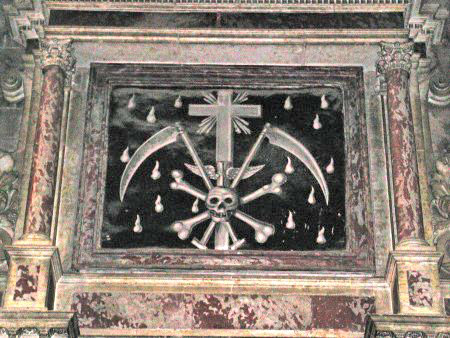
We also now have a better understanding of
the ancient image of the
skull and crossbones surrounded by little tongues of fire that is
prominently displayed in Auch Cathedral.
Years ago I read the story promoted in the book
Holy Blood, Holy
Grail, that Jesus had a wife and that she was Mary Magdalene. I
immediately consulted with friends in France who live in Marseille
about this so-called “well-known” legend. What I learned is that
yes, it was said that Mary Magdalene came to France accompanied by
other individuals. She was closely associated with St. Maximin, but
never, until the raft of books following
Holy Blood, Holy Grail, was
she thought to have been the wife of Jesus.
Clearly, in 1548, and much, much earlier, it was known that
Jesus
had a wife as is depicted in the statues of Auch Cathedral, but it
clearly wasn’t Mary Magdalene. We cannot even be certain that the
depiction of a "wife" means that literally, that it does not
indicate to us a process rather than an actual state of physical
marriage.
So, the question is: who was the wife of Jesus and does this
depiction suggests a "physical" wife, or does it depict an
Initiatory process?
I will deal with that question in a future volume, but for now, let
me share with the reader additional clues.
We come now to the intriguing link between
Marguerite of Navarre and
Leonardo da Vinci who died in 1519 while he was a guest of
Marguerite and her brother Francis. A Venetian ambassador of the
time praised Marguerite as "knowing all the secrets of diplomatic
art," and thus, a person to be treated with deference and
circumspection. We see here a definite clue since Fulcanelli
repeatedly referred to the Green Language as "The Language of
Diplomacy."
By 1508, Leonardo’s career was drawing to a close though it would
yet be ten years before his death. Only two paintings survive from
that period; the Louvre’s Virgin and Child with St. Anne and
St. John.
Leonardo had made Milan, ruled by the French, his home for some
time. In 1512, an alliance of Swiss, Spaniards, Venetians and papal
forces drove the French out of Milan which was a minor issue of
history for France, but a major disaster for Leonardo. He was about
60 years old and had been treated by the French with understanding
and compassion. Now, he suddenly found himself without patronage or
income, verging on total poverty. His fame had faded and, while the
new rulers of Milan were not openly hostile toward him, he was
certainly not accorded any honor or comfort.
In February of 1513,
Pope Julius II died and was succeeded by Leo X
- made famous by saying "It has served us well, this myth of Christ"
- a Medici. The Medici had never shown Leonardo any special favor,
but he apparently decided to throw himself on their mercy since they
were, after all, patrons of the arts.
In September of 1513, the aging Leonardo set off for Rome. Pope Leo
X was persuaded to give Leonardo a small commission - subject
unknown - but the result was a disaster. When Leonardo started the
project by compounding a special preservative varnish, the Pope
reportedly threw up his hands saying "This man will never accomplish
anything! He thinks about the end before the beginning!" Leonardo’s
notebooks record, around this time: "We should not desire the
impossible." and "Tell me if anything was ever done..."
Not surprisingly, Leonardo became ill. The nature of his illness is
unknown, but it is thought from other clues that he suffered a mild
stroke affecting his right side. (He was left handed, fortunately.)
Leonardo’s self-portrait was apparently made during this time. His
last painting was completed in Rome, noted to have been done without
commission, but due to some inner compulsion. It is in the Louvre:
St John.
Sick and forgotten in Rome, the French did not forget Leonardo.
Francis I, brother of Marguerite of Navarre, offered Leonardo a
manor house in France near the royal chateau of Amboise, and any
funds he might require for his needs, wants, and any project he
might, on his own, wish to undertake. Francis only wished the
pleasure of Leonardo’s company.
Leonardo set off for France taking with him his notes, his drawings,
his last two paintings: The St. John, The Virgin and Child with St.
Anne, and a portrait described as "a certain Florentine Lady."
When Leonardo arrived at the royal castle at Amboise, he was given
the title: "Premier peinctre et ingenieur et architecte du Roy" not
for anything he was expected to do, but for what he had done
already. Francis always went to see Leonardo, taking the view that
it was easier for a vigorous 22 year-old king to make a call on an
aging artist than vice versa.
Leonardo must have made quite an impression on Francis because, 24
years later, Benvenuto Cellini, then in the French service also,
wrote:
King Francis being violently enamored of his great talents took so
great a pleasure in hearing him discourse that there were few days
in the year when he was separated from him... He said that he did
not believe that there had ever been another man born into the world
who had known as much as Leonardo, and this not only matters
concerning sculpture, Painting and Architecture, but because he was
a great Philosopher.
It was in 1517, while Leonardo was at Amboise, that
Martin Luther
nailed his 95 theses to the door of the church at Wittenberg. Most
of his activities in France are unknown. He died on May 2, 1519.
Vasari, Leonardo’s biographer, raised a smoke screen around
Leonardo’s religious beliefs (or lack of them). In the first edition
of his "Lives of the Painters," published in 1550, he wrote that
"Leonardo was of such a heretical frame of mind that he did not
adhere to any kind of religion, believing that it is perhaps better
to be a philosopher than a Christian." In the second edition (1568),
he omitted the sentence, writing instead:
"He desired to occupy
himself with the truths of the Catholic faith and the holy Christian
religion. Then, having confessed and shown his penitence with much
lamentation, he devoutly took the Sacrament."
Leonardo himself had written about Christian funerals:
"Of the dead
who are taken to be buried: The simple folk will carry a great
number of lights to illuminate the journeys of all those who have
wholly lost the power of sight. O human folly! O madness of
mankind!"
But it seems that Leonardo was not an
atheist either. The name of
the Creator appears often enough in his writings and indicates that
he had an extraordinary conception of a divine power. Certainly, if
he had wished to be explicit about it in words, he was quite
capable. But he didn’t explain - except perhaps, in his art. Before
his death he wrote:
"See: one’s hopes and wishes to return to one’s homeland and origin
- they are just as moths trying to reach the light. And the man who
is looking forward with joyful curiosity to the new spring, and the
new summer, and always new months and new years - and even if the
time he is longing forever comes, it will always seem to him to be
too late - he does not notice that his longing carries within it the
germs of his own death.
"But this longing is the quintessence, the spirit of the elements,
which through the soul is enclosed in the human body and which
craves for return to its source. You must know that this very
yearning is the quintessence of life, the handmaid of Nature, and
that Man is a model of the world."
As he aged, Leonardo’s dark view of mankind and his general
pessimism grew. He was reported to erupt into fury liberally laced
with scatological phrases such as the diatribe about man penned by
Jonathan Swift:
"Men who can call themselves nothing more than a
passage for food, producers of dung, fillers up of privies, for of
them nothing else appears in the world, nor is there any virtue in
them, for nothing of them remains but full privies."
Francis I had such great respect for
Leonardo that he required
nothing of him at all - he just wanted to be able to drop in as
often as possible and talk to the Master. It was in France, an
"alien land," that Leonardo gave his final trumpet blast in an
apocalyptic series of drawings called "The Deluge" which he
predicted would one day inundate the earth and end the world of Man.
These drawings, almost abstract in their abandonment of traditional
artistic styles, were obviously vivid exercises of his imagination.
His scientific knowledge is applied here with devastating effect,
showing how puny are the means of man when pitted against nature.
"Ah, what dreadful tumults one heard resounding through the gloomy
air!" he wrote in the commentary to these drawings; "Ah me, how many
lamentations!"
His depictions of The Deluge were terrifying:
"Let the dark, gloomy air be seen beaten by the rush of opposing
winds wreathed in perpetual rain mingled with hail... All around let
there be seen ancient trees uprooted and torn in pieces by the fury
of the winds... And let the fragments of some of the mountains be
fallen down into the depths of one of the valleys, and there form a
barrier to the swollen waters of its rivers, which having already
burst the barrier rushes on with immense waves..."
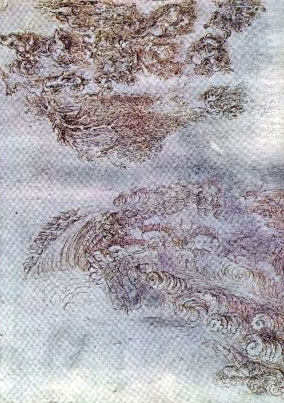 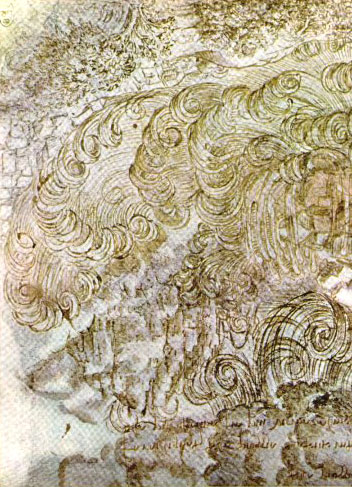
This was Leonardo’s Last Judgment on the World, his last message to
mankind. Strange that it is the message of Auch Cathedral, the
message of Fulcanelli, Kardec, Nostradamus, etc. And strange that
they are all tied together via their connections to Marguerite of
Navarre.
Recall that the burial scene of Christ in Auch Cathedral was
inspired by Margaret of Austria, who married into the family that
was in possession of the Shroud of Turin. Margaret’s husband,
Philibert de Savoie was a cousin of one of the bishops that was
involved in the commissioning of the work of the cathedral, Francois
de Savoie, and that Marguerite of Navarre, the second cousin of
Margaret of Austria, was closely associated with Auch Cathedral.
Remember: Marguerite of Navarre takes us right back to
Fulcanelli
via François Rabelais whose series, Le Tiers Livre des faicts et
dicts héroïques du bon Pantagruel (1546), was dedicated to her.
It was after the death of Leonardo that Marguerite became involved
in the movement for the reform of the church, meeting and
corresponding with the leading reformers of the period. In 1527,
apparently by her own choice, (rare in those days) Marguerite
married Henri d’Albret, King of Navarre (though most of his kingdom
was in Spanish hands). Henri d’Albret was the son of Catherine de
Foix, descended from a famous Cathar family.
Recall also that another of Marguerite’s associates and
correspondents was Jules Cesar Scaliger who was a close friend and
associate of Nostradamus, that Nostradamus, as mentioned, was born
in Alet-le-Bains, in Foix lands, and that Nostradamus also attended
school with Rabelais.
Recall: It was around 1531, Marguerite allowed a poem she had
written to be published, Miroir de l’ame pecheresse (Mirror of the
sinful soul). Marguerite gave a copy of Miroir to one of her ladies
in waiting, Anne Boleyn, and it was later translated into English by
Anne’s 12 year old daughter, Elizabeth I. Recall as well that Anne
Boleyn had previously been the lady in waiting to Margaret of
Austria before she went to serve Marguerite of Navarre.
The connections are just simply too much to ignore, too much to
consider "coincidence," in my opinion. And so it is that I believe
it is only in the brief context I have been able to present here
(more fully explicated in Secret History of the World), that we can
truly come to some understanding of the REAL "Da Vinci Code."
After his death, Leonardo left his notebooks and manuscripts to his
companion, Francesco Melzi. He took them all to his home near Milan
where he guarded that "as though they were religious relics." Until
Melzi’s death, they were in safe hands. On his death, he left them
to his son, a lawyer, trusting that he would honor them as well.
Apparently not.
The progress of dispersal began and the manuscripts
and unbound sheets were sold, stolen, given away, and scattered over
half the planet. In more recent years, attempts have been made to
assemble at least facsimiles, but no one knows how much was lost. In
the late 19th century, a great number of pages in the
possession of
the British Crown somehow disappeared and the guess is that they
were hidden, not destroyed. One has to, of course, wonder why?
In any event, as mentioned, there are portions of his notebooks that
have been collected together and a close study of his available
writings give us many clues as to what he wished to "speak" about in
his art. For example:
The mind of the painter must resemble a mirror, which always takes
the colour of the object it reflects and is completely occupied by
the images of as many objects as are in front of it. Therefore you
must know, Oh Painter! that you cannot be a good one if you are not
the universal master of representing by your art every kind of form
produced by nature. And this you will not know how to do if you do
not see thyem, and retain them in your mind.
We know very well that errors are better
recognized in the works of
others than in our own; and that often, while reproving little
faults in others, you may ignore great ones in yourself. To avoid
such ignorance in the first place make yourself a master of
perspective, then acquire perfect knowledge of the proportions of
men and other animals, and also, study good architecture that is so
far as concerns the forms of buildings and other objects which are
on the face of the earth; these forms are infinite and the better
you know them the more admirable will your work be.
The universal practice which painters adopt on the walls of chapels
is greatly and reasonably to be condemned. Inasmuch as they
represent on historical subject on one level with a landscape and
buildings, and then go up a step and paint another, varying the
point [of sight], and then a third and a fourth, in such a way as
that on one wall there are 4 points of sight, which is supreme folly
in such painters. We know that the point of sight is opposite the
eye of the spectator of the scene; and if you would [have me] tell
you how to represent the life of a saint divided into several
pictures on one and the same wall, I answer that you must set out
the foreground with its point of sight on a level with the eye of
the spectator of the scene, and upon this plane represent the more
important part of the story large and then, diminishing by degrees
the figures, and the buildings on various hills and open spaces, and
can represent all the events of the history. And on the remainder of
the wall up to the top, put trees, large as compared with the
figures, or angels if they are appropriate to the story, or birds or
clouds or similar objects; otherwise do not trouble yourself with it
for your whole work will be wrong.
When you have well learnt perspective and have by heart the parts
and forms of objects, you must go about, and constantly, as you go,
observe, note and consider the circumstances and behaviour of men in
talking, quarrelling or laughing or fighting together: the action of
the men themselves and the actions of the bystanders, who separate
them or who look on.
When you compose a historical picture take two points, one the point
of sight, and the other the source of light; and make this as
distant as possible.
Historical pictures ought not to be crowded and confused with too
many figures.
Of composing historical pictures. Of not considering the limbs in
the figures in historical pictures; as many do who, in the wish to
represent the whole of a figure, spoil their compositions. And when
you place one figure behind another take care to draw the whole of
it so that the limbs which come in front of the nearer figures may
stand out in their natural size and place.
The figure is most admirable which by its actions best expresses the
passion that animates it.
You must show a man in despair with a knife, having already torn
open his garments, and with one hand tearing open the wound...
A picture or representation of human figures, ought to be done in
such a way as that the spectator may easily recognize, by means of
their attitudes, the purpose in their minds. Thus, if you have to
represent a man of noble character in the act of speaking, let his
gestures be such as naturally accompany good words; and, in the same
way, if you wish to depict a man of a brutal nature, give him fierce
movements; as with his arms flung out towards the listener, and his
head and breast thrust forward beyond his feet, as if following the
speaker’s hands.
Thus it is with a deaf and dumb person who, when he sees two men in
conversation - although he is deprived of hearing - can nevertheless
understand from the attitudes and gestures of the speakers, the
nature of their discussion.
When you wish to represent a man speaking to a number of people,
consider the matter of which he has to treat and adapt his action to
the subject. Thus, if he speaks persuasively, let his action be
appropriate to it. If the matter in hand be to set forth an
argument, let the speaker, with the fingers of the right hand hold
one finger of the left hand, having the two smaller ones closed; and
his face alert, and turned towards the people with mouth a little
open, to look as though he spoke. And if he is sitting, let him
appear as though about to rise, with his head forward. If you
represent him standing make him leaning slightly forward with head
towards the people. These you must represent as silent and
attentive, all looking at the orator’s face with gestures of
admiration; and make some old men in astonishment at the things they
hear, with the corners of their mouths pulled down and drawn in,
their cheeks full of furrows, and their eyebrows raised...
The motions of men must be such as suggest their dignity or their
baseness.
Make your work carry out your purpose and meaning. That is when you
draw a figure consider well who it is and what you wish it to be
doing.
The limbs which are used for labour must be muscular and those which
are not much used you must make without muscles and softly rounded.
Represent your figures in such action as may be fitted to express
what purpose is in the mind of each; otherwise your art will not be
admirable.
Fame should be depicted as covered all over with tongues instead of
feathers, and in the figure of a bird.
Pleasure and Pain represent as twins, since there never is one
without the other; and as if they were united back to back, since
they are contrary to each other.
This represents Pleasure together with Pain, and show them as twins
because one is never apart from the other. They are back to back
because they are opposed to each other; and they exist as
contrairies in the same body, because they have the same basis,
inasmuch as the origin of pleasure is labour and pain, and the
various forms of evil pleasure are the origin of pain. Therefore it
is here represented with a reed in his right hand which is useless
and without strength, and the wounds it inflicts are poisoned. In
Tuscany they are put to support beds, to signify that it is here
that vain dreams come, and here a great part of life is consumed. It
is here that much precious time is wasted, that is, in the morning,
when the mind is composed and rested, and the body is made fit to
begin new labours; there again many vain pleasures are enjoyed; both
by the mind in imagining impossible things, and by the body in
taking those pleasures that are often the cause of the failing of
life. And for these reasons the reed is held as their support.
Evil-thinking is Envy or Ingratitude.
Envy must be represented with a contemptuous motion of the hand
towards heaven, because if she could she would use her strength
against God; make her with her face covered by a mask of fair
seeming; show her as wounded in the eye by a palm branch and by an
olive-branch, and wounded in the ear by laurel and myrtle, to
signify that victory and truth are odious to her.
[Leonardo’s quotes from: "The Notebooks of Leonardo Da Vinci"
compiled and edited from the original manuscripts by Jean Paul
Richter, Dover Edition, 1970, first published in 1883 by Sampson
Low, Marston, Searle & Rivington under the title "The Literary Works
of Leonardo da Vinci." Dover Publications, New York]
|
St. John. Louvre. It is said to be the most disquieting of
Leonardo’s work. Leonardo has transformed John, the alleged
precursor of Christ, from a gaunt ascetic to what can only be said
to be almost a hermaphrodite with soft, womanly flesh, glancing out
of the painting with a look that is not renunciation, but sly
mystery and devious invitation with finger pointing heavenward.
From Leonardo’s notebooks:
"The limbs which are used for labour must be muscular and those
which are not much used you must make without muscles and softly
rounded. Represent your figures in such action as may be fitted to
express what purpose is in the mind of each; otherwise your art will
not be admirable."
"Therefore it is here represented with a reed in his right hand
which is useless and without strength, and the wounds it inflicts
are poisoned. [...] And for these reasons the reed is held as their
support. Evil-thinking is Envy or Ingratitude."
"Envy must be represented with a contemptuous motion of the hand
towards heaven, because if she could she would use her strengthen
against God..."
What, exactly, was Leonardo trying to tell us about St. John?
|
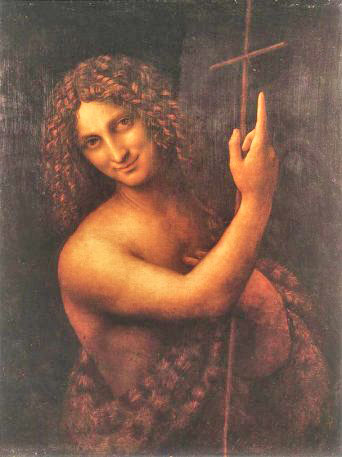 |
It is thus strongly suggested that, in every painting he ever
executed, Leonardo da Vinci was conveying messages. Not only that,
the messages were somewhat codified. We can extract general
principles from his writings and utilize them in examining his
works.
As time passed after the death of Leonardo, critics began to come
forward declaiming loudly that, "after all, Leonardo was only a man
and his paintings, like those of other artists, consisted simply of
colors applied to a surface. This was John Ruskin’s general opinion
paraphrased, and he made it clear that he thought the Master was
greatly overrated.
Renoir said:
"Leonardo da Vinci bores me."
The most dramatic attacks on Leonardo’s image came via
Sigmund
Freud. Working with what he mistakenly thought were historical
facts, he produced an essay "Leonardo da Vinci, and a Memory of His
Childhood." He suggested that Leonardo, lacking a father in the
first years of his life, had abnormally erotic relations with his
mother and later, when his father brought him into his household,
that his stepmother was "too affectionate," perhaps even erotically
so.
Freud’s biggest blunder, however, was the emphasis he placed on a
childhood dream of fantasy recorded by the artist himself of a large
bird alighting on his shoulder. Freud coupled this with a remark
made by Leonardo, to wit: "The act of procreation and everything
that has any relation to it is so disgusting that human beings would
soon die out if there were no pretty faces and sensuous
dispositions," and concluded that Leonardo was a latent homosexual.
That smear has stuck pretty well though there is absolutely NO
evidence that it is true.
Freud placed his reliance on a largely fictional work by
Dimitri
Merejkowski, "The Romance of Leonardo da Vinci," which included the
passage by Leonardo about the bird encounter. Unfortunately, the
word had been rendered "vulture" which sent Freud off into raptures
of humorless psychoanalysis based on ancient Egyptian mythology and
sexual-religious beliefs concerning the vulture-headed goddess named
Mut. Freud solemnly declaimed:
"We may question whether the sound
similarity to our word "mother" is only coincidental?"
The actual word that Leonardo used in describing his dream/fantasy
was "kite," a bird of the hawk family common in Europe. In short,
Freud’s dissertation on Leonardo was irrelevant. But then, in my
opinion, Freud himself is irrelevant.
Nevertheless, the word "kite" caught my attention. Here’s why:
June 20, 1998
Q: ... Okay, let me ask this, these guys who have researched this
Holy Bloodline business have sort of focused all the attention on a
particular line, purportedly the line of Jesus going into
the
Merovingian kings... This guy,
Pierre Plantard, seems to have more
or less created a geneology with their own validations... sort of
like describing x in terms of y and y in terms of x. Now, is this
Pierre Plantard a genuine carrier of the bloodline that we are
concerned with?
A: Partially.
Q: Then, that makes me think that the significant thing that we are
looking for is a convergence of the blood lines... These lines are
symbolized by the god figures, the children of Odin, and what we are
looking for is a place where these lines converge?
A: Yes.
Q: Well, what characteristics might an individual have who is a
product of this convergence?
A: Fair skinned and cleft chin.
Q: Well, Ark and F*** both have cleft chins, but C** and I don’t!
Does this mean...
A: We aren’t saying that all with these features are of that blood
line!
Q: So, you can have the bloodline and look quite different?
A: Yes.
Q: How many persons on the planet contain these
’convergant’
bloodlines?
A: 7367. Kites were used for cross communication between bloodline
members.
Q: Kites?! What do kites have to do with it? What the heck... you
guys are driving me NUTS! Do you mean kites as in paper and string
or kites as in the bird?
A: Yes, paper wood and string.
Q: ... (C) This is implying that such people know they have the
bloodline and keep in touch with each other? (L) Or, is this
something for the future when those of the bloodline wake up?
A: Yes. [to the] Latter.
Q: So, we need to go fly a kite...
(C) With a particular shape and
symbol...
A: Research kites.
Q: (C) The Japanese fly kites... and there are a lot of people who
hang banners outside their houses all the time...
A: Want revelations? Prepare for "Treasure" Hunt.
Q: Thanks a lot!
A: These quests energize you, Laura!
Q: Yes, they do. When I start finding things that connect, it is
like having little explosions of energy in the brain...
(A) Well, I
don’t understand these kites. They don’t fly by themselves, they are
on a string. You cannot see them at great distances... only a few
miles... what is the point of communicating this way with someone
who is only a few miles away?
A: Kites can be released, or left behind too!
Q: (A) When you release a kite, it falls down! Well, maybe we ought
to wait and see where this clue goes before we get stuck on the
technical aspects. Maybe it is just sort of a marker... We don’t
know if it will relate to a literal kite, or a reference to a kite,
a drawing of a kite... a carving... something will appear that will
connect, I am sure. It always does.
Indeed, it did. See: Leonardo da Vinci’s
Inventions of Flight which
includes portions of his The Kite and the Treatise upon the Flight
of Birds where he wrote:
"This writing distinctly about the kite seems to be my destiny,
because among the first recollections of my infancy, it seemed to me
that, as I was in my cradle, a kite came to me and opened my mouth
with its tail, and struck me several times with its tail inside my
lips."
(Codex Atlanticus)
The kite is a bird with a large wingspan, which uses air currents to
stay aloft while gliding. He studied the kite and other birds,
trying to learn how they flew so that he could successfully imitate
nature. Little is known about da Vinci’s private life, because he
usually never wrote about it in his journal. However, this is an
interesting exception because we see that Leonardo wrote that it was
his destiny to write about and study the kite, and also means that
he thought it was his destiny to build flying machines, and enable
men to fly.
When once you have tasted flight, you will forever walk the earth
with your eyes turned skyward, for there you have been, and there
you will always long to return.
[Leonardo]
Now, having assembled so many interesting clues, let’s go in a
slightly different direction. In 1483, Leonardo da Vinci painted
"The Madonna of the Rocks." (Full title: ’The Virgin of the Rocks
(The Virgin with the Infant Saint John adoring the Infant Christ
accompanied by an Angel)’) (Louvre).
Between 1506 and 1508, he
produced the second, or "London version," of the Madonna of the
Rocks. It is believed that the first was done to fulfill a contract
with the Milanese Confraternity of the Immaculate Conception.
Apparently, they didn’t like it and it passed into the hands of the
French. The Confraternity commissioned a second version in which Ambrogio da Predis, was to have a share of the work. Arguments and
lawsuits between him and Leonardo and the Confraternity followed,
and 25 years passed before the Confraternity finally got the version
they wanted.
It is in comparing the two paintings that one gets the feeling that
the first version must have conveyed a message that the
Confraternity wanted to suppress, and in the second version,
apparently acceptable to them, Leonardo managed to deliver his
message anyway. Either that, or he had little to do with the second
version.
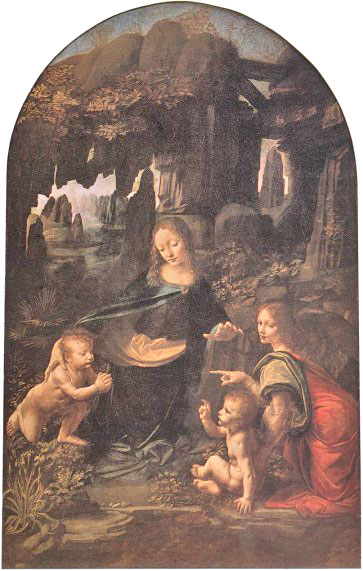
Virgin of The Rocks, Version One, Louvre, 1483
Notice the pointing
finger of contempt from the Angel to John the Baptist.
The Louvre version is generally accepted as Leonardo’s, but there is
continuing doubt about the National Gallery version.
In any event, the compositional changes reveal to us, apparently,
what the Confraternity objected to. They obviously objected to the
angel, seated beside the infant Jesus, pointing at the infant
John
the Baptist. They probably asked for halos to be included, but I
think Leonardo added the "reedy cross" across the shoulder of John
on his own initiative.
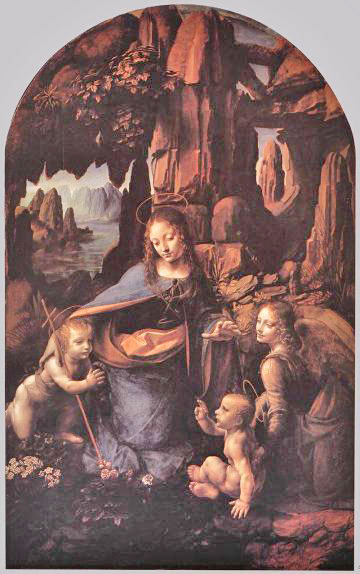
Virgin of the Rocks, Second Version, 1506
Notice the reed in the
right hand of John the Baptist.
The paintings are about equal in size, but the figures in the second
version are brought closer to the viewer and made "heavier" and
"more idealized" as though they are made of stone. The colors of the
second version have been subdued to the point of actually looking as
though they are dead bodies - a corpselike pallor seems to
deliberately emphasize that the "message" of the painting is
"death."
The item in the first painting that has received the most comment is
the strange, almost threatening hand of the Virgin in version One of
the painting. Let’s look at the hands from the two versions side by
side, keeping in mind all of Leonardo’s comments about "telling a
story" with his paintings, the gestures of the hands, and so on. I
don’t think the hand is threatening at all, as we will soon
discover.
 
Now, let’s take a look at another of Da Vinci’s works:
The Last
Supper...

The Last Supper is said to be the "freezing of a moment in time,"
the moment when Christ has just spoken the words, "One of you shall
betray me," and the disciples all react to the words with
magnificent displays of poses and gestures, "revealing the
intentions of their souls." Leonardo undoubtedly made many studies
before he began to paint, but only two of them are left to us today.
One of them is hastily - even roughly - drawn and shows ALL of the
figures, even if they are not lined up in a row behind the table.
Unable to place all of them at the table because of the small size
of the page he was drawing on, he placed four of them at the bottom.
BUT, his intention was clear because he placed a repeated shoulder/arm
of one of the disciples at the left of the upper row. In the sketch,
Leonardo was keeping to the standard iconographic style, leaving
Judas sitting alone on the near side of the table.
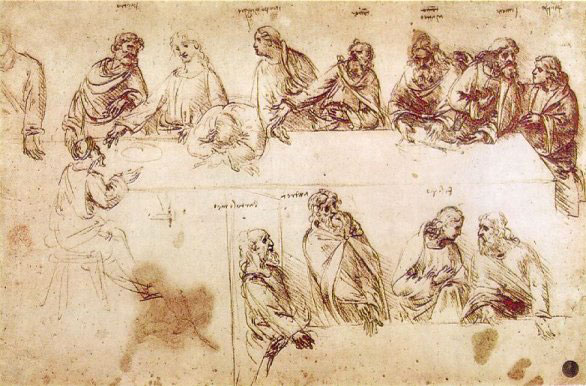
Looking at the study for the Last Supper, we realize that Leonardo
began with the "standard" ideas,
but somewhere along the way he
decided to do something remarkably different.
What seems to be the case is that, beyond freezing this moment in
time, Leonardo also intended other, deeper meanings as we can well
surmise from his commentaries on painting quoted above, compared
with the study above and the finished painting.
Many individuals have made much of the fact that this painting is
supposed to depict Jesus dining with his “wife,” Mary Magdalene next
to him. I certainly agree that the figure next to Jesus is obviously
a woman - a woman who is missing from the preliminarry study unless
she is the one who has all but collapsed face down next to Jesus,
but is it Mary Magdalene? Or is it someone else? Or is the clue
meant to point to something else altogether?
But, before I go further, let me suggest, from Leonardo’s own words,
a possible meaning of the two figures, appearing almost as twins,
facing somewhat away from each other, yet joined by the proximity of
their draped arms resting side by side on the table, forming the
"M", that may take us one step deeper:
Pleasure and Pain represent as twins, since there never is one
without the other; and as if they were united back to back, since
they are contrary to each other. [...] This represents Pleasure
together with Pain, and show them as twins because one is never
apart from the other. They are back to back because they are opposed
to each other; and they exist as contraries in the same body...
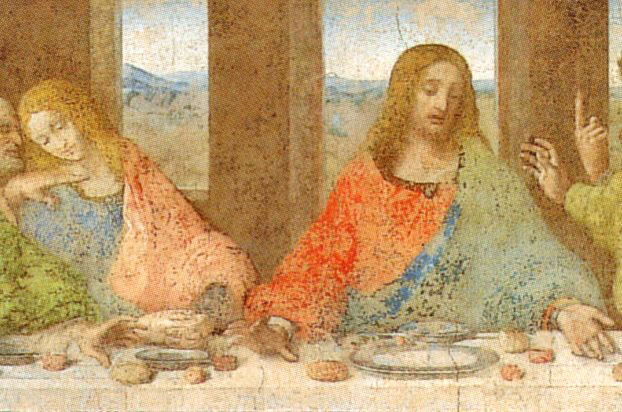
Leonardo also had formulas for the hands that were to "match" the
nature of the discourse of the subject of the painting:
When you wish to represent a man speaking to a number of people,
consider the matter of which he has to treat and adapt his action to
the subject. Thus, if he speaks persuasively, let his action be
appropriate to it. If the matter in hand be to set forth an
argument, let the speaker, with the fingers of the right hand hold
one finger of the left hand, having the two smaller ones closed; and
his face alert, and turned towards the people with mouth a little
open, to look as though he spoke.
Considering the announcement that Jesus is supposed to have just
made in the Last Supper, the aspect of his hands is most
interesting. We notice the supplicating gesture of the left hand,
but the right hand is truly curious. It was only after I had looked
at it for a bit that I realized what it reminded me of: The Virgin
of the Rocks. Let’s look at the hands side by side:
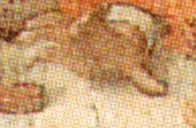  
Jesus hand, Last Supper Mary’s hand, Louvre Mary’s hand, London
We actually see that the right hand of
Jesus in the Last Supper
matches almost exactly the left hand of Mary in the Virgin of the
Rocks. In other words, whatever was being "said" by the hands in
both paintings was the same thing. But, of course, in the Last
Supper, according to the "plot" of the story, Jesus was about to
take up a piece of bread and dip it in the bowl together with Judas
whose hand is also reaching in a strange way. Is the implication
that John the Baptist, in the Virgin of the rocks, was a sort of
"Judas?"
Another controversy about the Last Supper has to do with the
two
“anomalous hands” in the painting. In the following image, I have
taken a high resolution scan of a professional photograph purchased
on site in Milan by a member of the Quantum Future Group. (No photos
are allowed to be taken by tourists.)
I enlarged the photo and
circled each evident or partly evident hand in the painting. I have
placed a number above the head of each individual showing how many
hands THAT particular individual has showing. I then cut the image
so that I could fit it on the page in two parts.
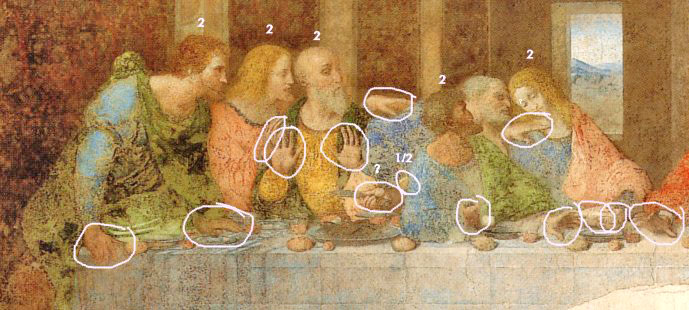
I have placed question marks over the "questionable" hands,
the one
holding the knife which seems to belong to the man whispering in the
woman’s ear.
Also, I would suggest that the his other hand, making
the "head cutting" motion at the woman’s neck
is not altogether
anatomically impossible, but it is certainly awkward.
But perhaps
"awkwardness," or "twistedness" is what Leonardo intended to convey
about St. Peter?
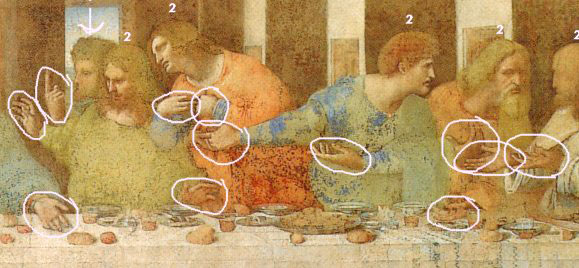
Above, you see the one person with only ONE hand in view,
his
upraised finger pointing insolently to heaven as in the St. John
painting, Leonardo’s last painting.
There are thirteen people at the table and, if we count the hands,
we have 25, because one hand is hidden: the one belonging to the man
with the upward pointing finger.
The figure whispering in the ear of the woman has been identified as
St. Peter. One of the hands that must belong to him is found making
a “cutting motion” at the throat of the woman seated next to Jesus.
It is obvious that Leonardo intended to convey a message because he
spoke clearly enough about completing bodies that are to be behind
other bodies so that the anatomy might be accurate. Here we have the
only other study from the Last Supper known to be extant, next to
the arm of St. Peter from the painting:
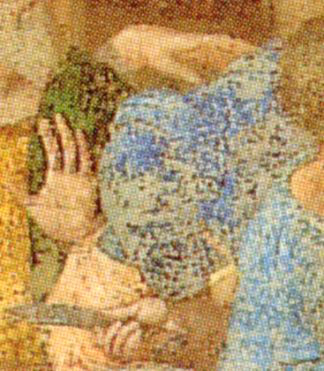 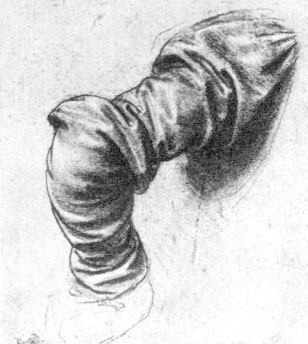
It is clear that the hand with the knife and the hand making the
cutting motion at the neck of the woman both belong to St. Peter.
Let’s look again at what Leonardo wrote:
The figure is most admirable which by its actions best expresses the
passion that animates it.
...when you place one figure behind another take care to draw the
whole of it so that the limbs which come in front of the nearer
figures may stand out in their natural size and place.
You must show a man in despair with a knife.... A picture or
representation of human figures, ought to be done in such a way as
that the spectator may easily recognize, by means of their
attitudes, the purpose in their minds. ...The motions of men must be
such as suggest their dignity or their baseness.
Make your work carry out your purpose and meaning. That is when you
draw a figure consider well who it is and what you wish it to be
doing.... Represent your figures in such action as may be fitted to
express what purpose is in the mind of each... Envy must be
represented with a contemptuous motion of the hand towards heaven,
because if she could she would use her strength against God...
So, most certainly, not only might we have "Twin Representations" in
the figures of Jesus and the woman to his right as the "Pleasure,
Pain Principle," but also the hand holding the knife that emerges
from behind Judas Iscariot is holding a knife: "You must show a man
in despair with a knife..." and, if we suppose that the bread, the
Eucharist, is to represent "the body of Christ," then the action of
the knife over the bread might very well be Envy making a
"contemptuous motion of the hand towards heaven." Put that together
with the head cutting motion and the whispering in the ear:
conspiring, and a rather unpleasant picture of St. Peter emerges. It
seems that Peter is hiding his actions behind Judas.
Curious.
As I continued to study this painting, I noted something else that
seems to be quite remarkable:
If you use the hand with the knife, the hand making the cutting
motion, the right hand of Jesus, his forehead, and the palm of his
left hand as “points,” you have exactly traced the constellation of
Cassiopeia MIRRORED.
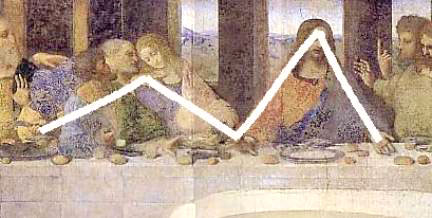
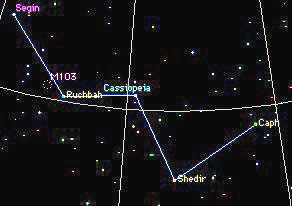
Now, in order to understand the possible implications of this
strange figure that is clearly evident in the painting, let me
repeat again the somewhat obscure information about this famous Star
group cited earlier in this article.
"The star’s name comes from a star picture envisioned by the
Arabic
peoples that is very different from the Greek conception of the
constellation," Teske explains. "Despite this, its Arabic name was
inserted into the Greek conception of Cassiopeia around 400 years
ago."
That would put the insertion of the Arabic names
right around the
time of Da Vinci and the circle connected to Auch Cathedral. So,
certainly they were aware of the following:
The Arabic names of the main stars of Cassiopeia give some clues to
the esoteric meaning of the constellation, among them being “breast,” (schedir-seder?)
“hand,” “hump of the camel,” “knee,” and “elbow,” all of which are
esoteric symbols found in many arcane works. The Arabs called the
entire constellation the seder tree. Earlier Arabs thought that this
constellation was “the large hand stained with henna,” the brightest
stars being the fingertips.
Which reminds us again of the strange, large hand of the Virgin of
the Rocks, the hand that is the mirror image of the right hand of
Jesus in the painting of the Last Supper.
Cassiopeia is a beautiful constellation at the end of the Milky Way
Galaxy and is associated with what is known as the Perseus
Constellation Family. It is in the zodiacal sign of the Ram wherein
one finds the stars Shedir, “The Breast,” (the star on the forehead
of Jesus), Ruckbah, (knee) “The Enthroned,” (the star on the hand
making the cutting motion at the throat of the woman next to Jesus),
and Dat al-Cursa, “The Seated.” The Chinese called Cassiopeia Ko
Taou, or a “doorway.” Some saw this constellation in the shape of a
key.
Hanging nearly overhead in November’s mid-evening sky is the
W-shaped constellation we know as Cassiopeia... Observers who face
north will see the star called "Caph," meaning the palm of a hand,
on the left end of Cassiopeia’s upside-down "W."
Interesting that there is the "palm of the hand" and the "palm
branch," located at the upturned palm of Jesus? Also strange that
Cassiopeia is referred to as being an "upside down W rather than the
more obvious M - an attempt to "hide" a relationship?
In 1893, E. W. Bullinger wrote about Cassiopeia:
The captive delivered, and preparing for her Husband, the Redeemer.
In the last chapter we saw the woman bound (Andromeda); here we see
the same woman freed, delivered, and enthroned.
ULUGH BEY says its Arabic name is
El Seder, which means the freed.
With the hands of the woman in The Last Supper clasped together as
though "bound," and the cutting motion being made by St. Peter,
concealing his knife, we certainly can see a relationship here.
In the Denderah Zodiac (Egyptian) her name is Au-Set - Isis - which
means set up as Queen. ALBUMAZER says this constellation was
anciently called "the daughter of splendour." This appears to be the
meaning of the word Cassiopeia, the enthroned, the beautiful. The
Arabic name is Ruchba, the enthroned. This is also the meaning of
its Chaldee name, Dat al cursa. There are 55 stars in this
constellation, of which five are of the 3rd magnitude, five of the
4th, etc.
This beautiful constellation passes vertically over Great Britain
every day, and is easily distinguished by its five brightest stars,
forming an irregular "W." This brilliant constellation contains one
binary star, a triple star, a double star, a quadruple star, and a
large number of nebulae. In the year 1572 Tycho Brahe discovered in
this constellation, and very near the star k (under the arm of the
chair), a new star, which shone more brightly than Venus. It was
observed for nearly two years, and disappeared entirely in 1574.
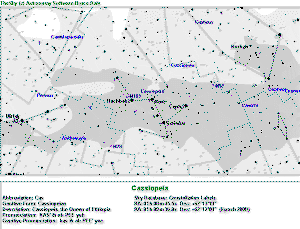
The brightest star, a (in the left breast), is named
Schedir
(Hebrew), which means the freed. The next, b (in the top of the
chair), likewise bears a Hebrew name - Caph, which means the branch;
it is evidently given on account of the branch of victory which she
bears in her hand. She is indeed highly exalted, and making herself
ready. Her hands, no longer bound, are engaged in this happy work.
With her right hand she is arranging her robes, while with her left
she is adorning her hair. She is seated upon the Arctic circle, and
close by the side of Cepheus, the King. This is "the Bride, the
Lamb’s wife, the heavenly city, the new Jerusalem," the "partakers
of the heavenly calling."
Cassiopeia is visible all night and all year and neither rises or
sets, but instead circles endlessly around our northern Pole star
[Polaris]. The Big Dipper is located on the opposite side of the
pole to Cassiopeia.
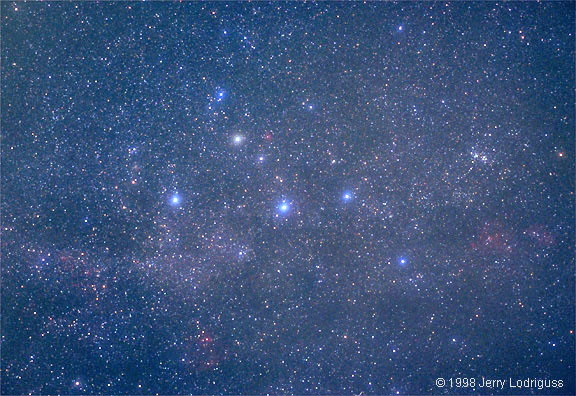
The Lithuanians refer to the stars in
Cassiopeia as ’Rider’, ’Justandis ’ or ’food carrier’ - breast? - or
’Abakukas’ Star’ and ’Mary’s stars’. This brings us to what Sir John Rhys wrote about Cassiopeia:
We have to look for help to enable us to identify the great ‘SHE’
persistently eluding our search in the syntax of the Welsh language.
Only two feminine names suggest themselves to me as in any way
appropriate: One is Tynghed, ‘fate or fortune,’ and the other is
Don, mother of some of the most nebulous personages in Celtic
literature.
It is from Don that Gwydion, the bard and arch-magician, and
Gofannon the smith his brother, are called sons of Don; and so, in
the case of Arianrhod, daughter of Don, mother of Ilew, and owner of
the sea-laved castle of Caer Arianrhod, not far distant from the
prehistoric mound of Dinas Dinlle...
In Irish legend, we detect Don under the Irish form of her name,
Danu or Donu, genitive Danaan or Donaan, and she is almost singular
there in always being styled Divinity. From her the great mythical
personages of Irish legend are called Tuatha De Danaan, or ‘the
Goddess Danu’s Tribes,’ and sometimes Fir Dea, or ‘the Men of the
Divinity.’
The last stage in the Welsh history of Don consists of her
translation to the skies, where the constellation of Cassiopeia is
supposed to constitute Ilys Don, or Don’s Court.[5]
Was Leonardo da Vinci indicating Cassiopeia in his painting of the
Last Supper? Were Marguerite of Navarre, Rabelais, Nostradamus,
Francis I, Anne Boleyn, and others, part of a group in contact with
"Us in the Future?"
So, let me return now to the remarks about stars made by
Canseliet
made 20 years apart, that, juxtaposed, reveal something quite
marvelous:
From the FIRST edition: I know, not from having discovered it
myself, but because I was assured of it by the author more than ten
years ago, that the key to the major arcanum is given quite openly
in one of the figures, illustrating the present work. And this key
consists quite simply in a colour revealed to the artisan right from
the first work.
I suspect that the reader has, by now, figured out that
Canseliet
and Fulcanelli were very tricky. And so, we look at this clue and
try to think of what Canseliet is saying. He says that the clue is
in a “figure illustrating the present work,” that it is revealed
“right from the first work” and in the preface to the second
edition, adds the clue that the subject of the star “leads us
straight into Fulcanelli’s text” saying that “right from the
beginning my Master has dwelt on the primary role of the star…”
We turn again to the very beginning of Fulcanelli’s text:
The strongest impression of my early childhood - I was seven years
old - an impression of which I still retain a vivid memory, was the
emotion aroused in my young heart by the sight of a gothic
cathedral. I was immediately enraptured by it. I was in an ecstasy,
struck with wonder, unable to tear myself away from the attraction
of the marvellous, from the magic of such splendour, such immensity,
such intoxication expressed by this more divine than human work.
Varro, in his Antiquitates rerum humanorum, recalls the legend of
Aeneas saving his father and his household gods from the flames of
Troy and, after long wanderings, arriving at the fields of Laurentum,
the goal of his journey. “Laurente (Laurentium) is cabalistically
l’or enté (grafted gold)”. And so indeed, we have been led to a
color!
Abbe Boudet:
The Auscii easily became skillful in working in gold; this metal was
almost like a weed in their region, and diverse historians say that
the avid Greek and Phoenician merchants, coming back to their
countries, used the gold gathered in the Pyrénées for ballast in
their vessels.
Is the Da Vinci Code also the
Mystery of the Cathedrals we have been
led to by Fulcanelli?
Patrick Rivière, alchemist, student of Eugene Canseliet, disciple of
Fulcanelli:
Throughout her exposé, Laura Knight-Jadczyk refers to two powerful
works of the scientist-alchemist Fulcanelli:
The Mystery of the
Cathedrals and Dwellings of the Philosophers. She applies her vast
knowledge to the continuation of his work. [...]
As to her inspiration, what can we say, and, from whence could it
come, if not the Light of the stars? [Patrick Rivière’s Preface to
The Secret History of the World]
[1] In my partial autobiography, Amazing Grace, I have discussed, at
some length, many of the surpassingly strange events that began
shortly after I was born, and which have continued to the present
day, that give evidence of the fact that there is, indeed, within
mysterious groups, some sort of extraordinary interest in my
existence and work. It is clear from the objective evidence that
some of these groups do not wish to kill me, but most definitely
wish to control me, while others wish to protect me and ensure that
I succeed in some “mission” of which I have very little conscious
awareness, but apparently, am discovering in a satisfactory way “one
step at a time.”
[3] Inserted into text.
[4] Inserted into text.
[5] John Rhys, Celtic Folklore
|





















